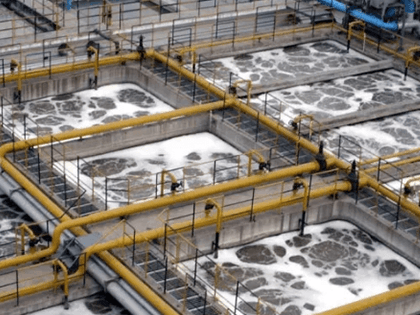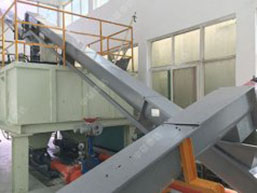With the development of economy and industry, the production of textile sludge is increasing, which has caused many environmental pollution problems and attracted widespread attention from all over the world. In 2017, the production amount of textile sludge in China exceeded 20 million tons (calculate based on 80% moisture content). Textile sludge is mainly composed of organic solid, inorganic solids, heavy metals, dyes, auxiliaries and surfactants. Components are complex and difficult to degrade. At present, treatment and disposal of textile sludge mainly use urban sludge treatment and disposal technologies, such as stabilization, dewatering, incineration and etc. In the process of sludge treatment, enhanced sludge dewatering can effectively reduce the moisture content and sludge volume reduces the transportation and disposal costs of sludge. Water in sludge can be divided into free water and bound water. Mechanical thickening and dehydration process can effectively remove free water and the bound water is firmly bound by the extracellular polymer (EPS) difficult to remove. Especially textile sludge, flocculent grid firmly restrains the bound water. In response to this situation, Zonelion Taeda has proposed a variety of thermal drying technologies to meet drying needs of textile sludge in different regions. After drying, it can be used as fuel for incineration to replace the consumption of raw coal so that to reduce the production cost of the enterprise or other resource utilization methods. If you need deep resource-based technical solutions, you can also contact us for entire deep processing technology and equipment manufacturing support services.
In terms of textile sludge drying reduction, Zonelion Taeda recommends following drying technologies and equipment that have been optimized for many years and are highly praised: low-temperature belt drying system, waste heat low-temperature drum drying system, steam rotary drum drying system, rotary drum sludge drying system, air swept rotary wing drying system. You can click on the "Recommended Process" below for details of above dryer and corresponding technologies. You can also call us directly for quotation and technical support.
1、High thermal efficiency and low drying cost
New internal structure strengthens material cleaning and heat conduction function and eliminate sludge sticking phenomenon. It can well adapt to material; moisture and stickiness. Heat exchanging area is increased and drying efficiency is improved. Operating parameters can be changed according to different materials. Entire drying system adopts variable frequency speed control to make material heat exchange in the dryer more fully. Coal consumption (other fuels are optional) and power consumption are decreased by 20-25% compared with ordinary dryers. From feeding to discharging, whole process runs in a full closed environment which can prevent entrance of cold air to system. Heat source utilization rate is improved and final product quality can be guaranteed.
2、Reliable running and good stability
New type of feeding/discharging device avoids feeding block, discontinuity, unevenness and material returning. The drying system greatly reduces abrasion and power consumption. It greatly reduces abrasion between catch wheel and riding wheel. Operation is more stable and reliable.
3、Wide fuel application and environmental friendly
Fuels can be coal, oil, natural gas, and liquefied gas. It can be determined according to material requirements and local natural advantages to improve production efficiency and economic benefits. Our company’s new produc, coal gasifier and biomass combustion furnaces are used as heat carriers. Whole process is featured in energy saving, environmental protection, safety and sanitation, no pollution to raw material and high thermal efficiency. Its thermal efficiency is 30% higher than combustion furnace. One operator is enough. No need to charge coal circularly. It can be stopped anytime according to demands.
4、High automation level and fulfill real time production supervision
Whole system can be equipped with PLC automatic control. The system includes advanced detection equipment like temperature detection, pressure detection, temperature adjustment (adjustable at any time according to material needs), automatic fault alarm, automatic protection shutdown and other functions. It can also be equipped with industrial television monitoring system for inspecting and controlling of production status and situation so that to make drying equipment better meet demands.
-
 Low-temp Belt Drying System
Low-temp Belt Drying System
-
 Exhaust Heat Drum Drying
Exhaust Heat Drum Drying
-
 Steam Rotary Drying System
Steam Rotary Drying System
-
 Rotary Drum Drying System
Rotary Drum Drying System
-
 Air Swept Drying System
Air Swept Drying System
| Model | Working principle | Working temperature | Heat source | Occupation area | Brand | Capacity |
| ℃ | t/h |
| MED | Hot air rotary drum dryer | 200-750 | electricity, gas, oil, coal and biomass pellets | Middle | Taeda | 0.5-50 |
| WWD | Circulation hot air mesh belt dryer | 60-300 | electricity, gas, heat conduction oil, hot water,exhaust gas, heat | Large | Zonelion | 0.05-5 |
| OSC | Airflow fluid bed dryer | 120-750 | electricity, gas, oil, coal and biomass pellets | Very small | 中联泰达 | 0.1-10 |
| GD | Steam tube rotar drum dryer | 100-170 | steam, heat conduction oil, hot water | Relatively large | Taeda | 0.1-8 |
| WRC | Low temperature large air volume rotary drum dryer | 45-750 | flue gas, exhaust gas, steam heat exchanging | Relatively large | Zonelion | 0.1-20 |
 中文
中文 English
English Home
Home













